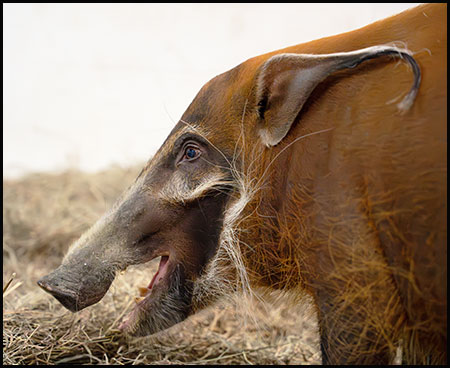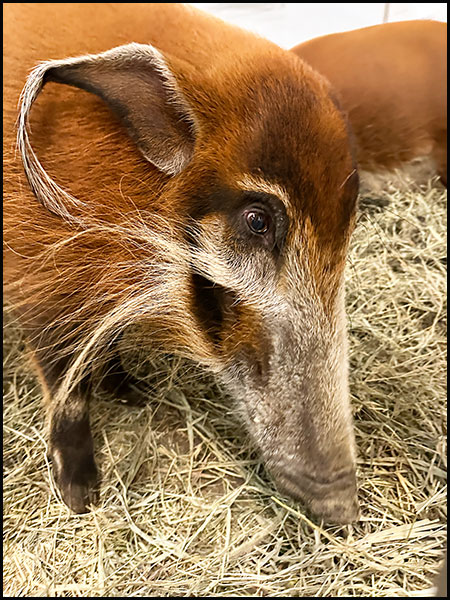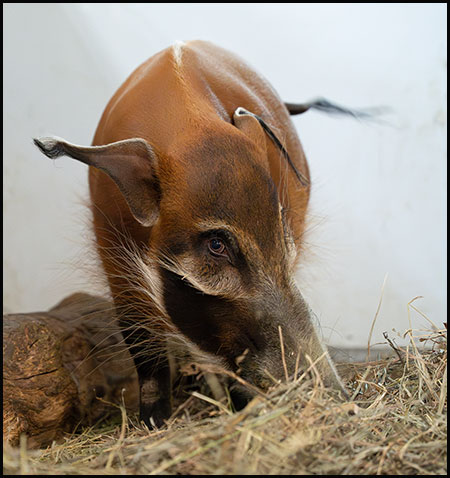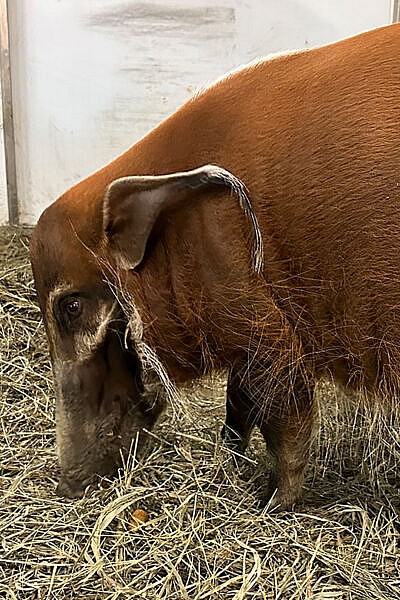Two redheaded charmers from Texas arrived in African Rift Valley earlier this month, complete with gorgeous ear tassels and pointy hooves. While they complete their routine quarantine period behind the scenes, Red River hog sisters, Rey and Finn, are cooing their way into the hearts of their keepers. Hopefully, the Zoo’s male Red River hog, Augustus, will be just as excited to welcome them to the family.

After their quarantine, they’ll start exploring more spaces and getting to know 17-month-old Augustus, known as “Gus” around here. In the meantime, keepers are getting to know the girls.
“They’re gorgeous animals, and these two are extremely vocal,” said Lauren Phillippi, lead animal keeper in African Rift Valley. “They have been making quiet, content ‘cooing’ sounds to each other and to us when we approach them. They like to do things together, like forage, solve puzzle feeders, roll around in the hay and snuggle while they sleep.”
The 7-year-old sisters were born in the same litter at another zoo accredited by the Association of Zoos and Aquariums. Rey is the leader of the two, and she is a bit bigger than Finn. Rey has darker orange-brown coloration compared to Finn’s much lighter white-and-brown face. Finn is a little more cautious. Being bold and outgoing, Rey is quick to approach keepers, wasting no time to communicate that she is a big fan of belly rubs.

“We quickly noticed how tactile these two are,” said Phillippi. “They enjoy enrichment that requires a lot of motor skills, and they like to get scratches from keepers. Especially Rey.”
Keepers use wooden back scratchers and their hands to give Rey the tactile interaction she likes. Just a few seconds into a scratch session, 165-pound Rey gives an enthusiastic lean and a floor-shaking plop onto her side. She knows how to give keepers every opportunity to scratch her sides, belly and back. Her care team is happy to oblige.
“We’re using this time to develop relationships with them,” said Phillippi. “We want to build that rapport and make sure they know that they’re going to live with choice and control here.”
Finn and Rey are already willingly approaching keepers and staff from behind a protective barrier. They’re also taking training treats well and moving to different spaces when asked. Next, keepers will work on target training and then more complex voluntary behaviors that allow them to care for the girls.
The big question: when will the sisters meet Gus? Finn and Rey are used to sharing space with other hogs, as is Gus. Once the sisters have completed quarantine, the team will introduce the group with a protective barrier between Gus and the girls. Then, based on the hogs’ behaviors toward each other, they’ll move towards sharing space without barriers between them.

The goal is for all three hogs to live together full-time. Red River hogs are social animals, often living in groups, and Finn and Rey came to CMZoo on a breeding recommendation with Gus. At 17 months old, Gus is approaching the age when Red River hogs typically reach reproductive maturity. Red River hogs’ usual breeding season ends in April, so depending on their interactions and Gus’ maturity, hoglets could be here as soon as this summer. More likely, their first chance at reproducing will be next year.
If the hogs eventually welcome babies, all three would be first-time parents, making their genetics valuable to the Red River Hog Species Survival Plan and the population in human care.
When Finn and Rey are ready to explore spaces where guests can see them, the Zoo will provide updates.

